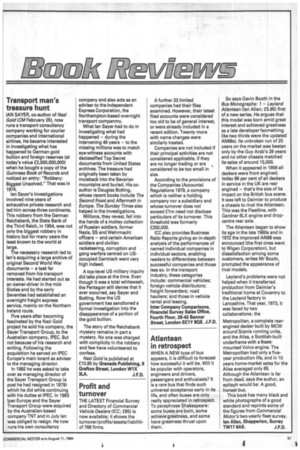Transport man's treasure hunt
Page 59

If you've noticed an error in this article please click here to report it so we can fix it.
IAN SAYER, co-author of Nazi Gold (CM February 25), now runs a transport consultancy company working for courier companies and international airlines. He became interested in investigating what has happened to German gold bullion and foreign reserves (at today's value £2,500,000,000) when he bought a copy of the Guinness Book of Records and noticed an entry: "Robbery: Biggest Unsolved." That was in 1974.
Ian Sayer's investigations involved nine years of exhaustive private research and led him across three continents. This robbery from the German Reichsbank, the State Bank of the Third Reich, in 1954, was not only the biggest robbery in history but for many years the least known to the world at large.
The necessary research led to Ian's acquiring a large archive of original Second World War documents — a task far removed from his transport interests. He had started out as an owner-driver in the midSixties and by the early Seventies had established an overnight freight express service, mainly on the Northern Ireland route.
Five years after becoming fascinated by the Nazi Gold project he sold his company, the Sayer Transport Group, to the Australian company, IPEC. But not because of his research and writing. Following the acquisition he served on IPEC Europe's main board as adviser to the managing director.
In 1982 he was asked to take over as managing director of the Sayer Transport Group (a post he had resigned in 1979) which he did while continuing with his duties at IPEC. In 1983 Ipec Europe and the Sayer Transport Group were acquired by the Australian-based company TNT and in July Ian was obliged to resign. He now runs his own consultancy company and also acts as an adviser to the Independent Express Corporation, the Northampton-based overnight transport corripanmy.
What Ian Sayer had to do in investigating what had happened — during the intervening 40 years — to the missing millions was to match eye-witness accounts with declassified Top Secret documents from United States archives. The treasure had originally been taken by muleback into the Bavarian mountains and buried. His coauthor is Douglas Batting, whose recent books include The Second From and Aftermath in Europe. The Sunday Times also helped in the investigations.
Millions, they reveal, fell into the hands of a motley collection of Russian soldiers, former Nazis, SS and Wehrmacht officers — and certain American soldiers and civilian racketeering, corruption and gang warfare centred on USoccupied Garmisch went very high indeed.
A top-level US military inquiry did take place at the time. Even though it was a total whitewash, the Pentagon still denies that it ever occurred, say Sayer and Batting. Now the US government has sanctioned a formal investigation into the disappearance of a portion of the gold bullion.
The story of the Reichsbank mystery remains in part a mystery. No one was charged with complicity in the robbery and few have volunteered to confess.
Nazi Gold is published at £10.95 by Granada Publishing, 8 Grafton Street, London W1X 3LA. J.F.D.




















































































